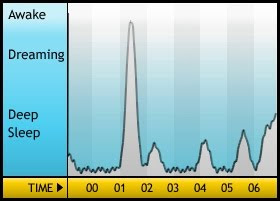Sleep Tracking
At CES in January, I was lucky enough to be given a Zeo sleep machine by an employee after a long conversation about their product. Was it too good to be true? How does it work, and most importantly, do they need user experience researchers??

It seems they have actually done a good bit of research and the ease of use is high. I intended to do an "out of box" post...but haven't yet. Instead, I'm excited today to share some comparative data having just found out about the iPhone Sleep Cycle app.
Cost: The Zeo retails for $249 and the iPhone app for 0.99 cents. Wow. So what's the difference?
Goal: In a nutshell, the iPhone App captures data and shares it, but doesn't look for the comprehensive picture of your life to help you significantly change your quality of sleep. The Zeo is really more of a medical tool, a way to help understand your patterns, lifestyle and why you are or are not getting enough of the right kind of sleep. For fun, get the App. For issues, get the Zeo.
How it works: Both devices do offer an alarm that will wake you when you are in light sleep and not in deep sleep around the time you request an alarm. You wake up rested rather than jarred out of a deep sleep. The App works simply by placing the phone on your bed. The accelerometer does the rest. The Zeo works by reading data send from a quite comfortable (but unattractive) headband you wear during sleep to the machine at your bedside.
The process: I must admit, however, that I'm not a person who enjoys lots of surveys, questions and daily tracking (despite the fact that I love to design them for others!). Zeo is intensive. You need to give it a lot of information if you are truly wanting to learn and change your sleep. I'm more of the mildly curious type, just wondering how well, and how many hours I slept and how it compares overall. I notice that caffeine days and the one night I had a beer near bedtime result in reduced sleep quality. Good to know...
But, I want to share the information quality because it is an interesting comparison.
Shot #1 - The sleep machine the morning of Feb. 3. The white lines on the graph were added in Photoshop so you can see the info. The graph shows, top to bottom, Wake, REM, Light and Deep sleep. For a person in my age range, a good "sleep number" average is 74. That estimates 6.8 hours of sleep, 1.4 hours of REM, 56 minutes of Deep and 28 minutes of waking during the night.

Myzeo.com: The above images are information you see at www.myzeo.com after plugging in the SD card that lives in the device and logging in to your account. You can see detailed information about your sleep. You also have the opportunity to fill in a journal about your activity levels, alcohol and caffeine intake and other habits that may affect your sleep.
Feb. 3 I had 6.58 hours of sleep, 2:09 of REM, 1:07 of deep and 30 minutes awake.
Looks like I had a good night's sleep! However, I am admittedly sluggish this morning...
Sleep Cycle app: Finally, this is the data you see from the iPhone app. As you can see, for .99 it's not a lot, but for many, it's just enough! However, this does not really seem to map to the Zeo data from the same night, Feb. 3. According to this screen, I had various levels of deep sleep and no dreaming sleep. The general rise and fall seems to map, but the details leave much to be desired. However, as an alarm to wake you during light sleep, it seems to be successful.
This is just the first night of data, but so far, the Zeo wins for accuracy and real behavior change, the iPhone wins for a cost, a nice alarm and a general sense of things.





Comments
Any idea how hackable the headband is? I like the data it gets, but don't like that data being hosted/owned on a special-purpose site.
I don't know, but would love to hack the headband (other ideas and projects). Any way I can assess the "hackability?"
As for Sortend, yeah, not sure what's up with that.
-Janna